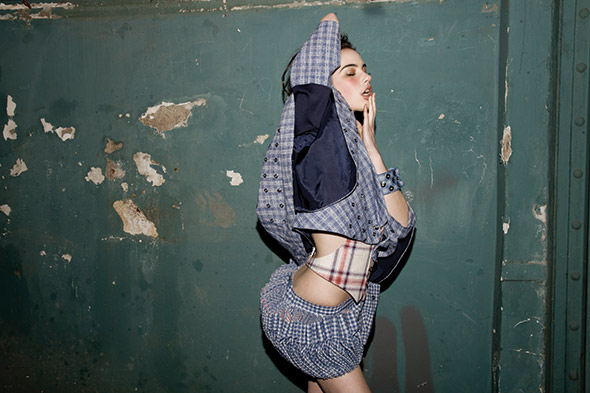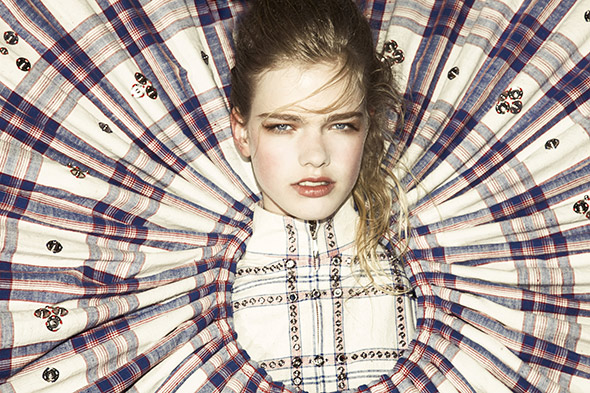Concept couturier Jan Taminiau plays by the rules of romantic reverie
Text by Michael Cohen
Photography by Petrovski & Ramone

A highly conceptual creator, Jan Taminiau designs each couture and ready-to-wear garment along well developed themes that have attracted worldwide attention for their intellectualism, romanticism and genuine craftsmanship. His collections beg to be examined closer inside and out. With Passe-Partout F/W 2008, he took a general French term for photo matting and translated it into a concept of beautiful silhouettes that both outlined and highlighted the body. His eighth and most recent collection Check, Check Mate! is a six-look, haute couture concept with political undercurrents. The 360-degree video of the collection invites the world to see the vision rather than the reviews.

Can you explain the metaphor for games in Check, Check Mate?
More and more, I’m beginning to understand how fashion works. It is similar to playing a game, like chess.
What’s going to be your next move to conquer your contestant?
In fashion, you compete in a positive way, such as, how to get the most exposure for my label Jamtaminiau. Besides the term “checkmate” in chess, we also look at the exact meaning of the words “check” and “mate.”
What purpose does the check pattern serve for this collection?
A red, white and blue checkered fabric forms the basis of the collection Check, Check Mate! It is an antique, hand-woven Chinese fabric, fringed with Swarovski crystals and decorated with traditional embroidery. The fabric is worked with metal press buttons and the application of these renders the pieces multifunctional: they allow play between the shapes of the pieces and influence the movement. In the checkered pattern, you can see the movement of lines. For me, this is a solid view. The checkered pattern of the fabric stands for a chessboard, as it also stands for globalization. In the Netherlands we see the colors red, white and blue as something typically Dutch, while the antique fabric is from China. The same thing happens with the tulip. The majority of the people relate the tulip to the Netherlands, but originally the tulip is from the Middle East.
Is there a point where you grew from student to designer?
To point out one moment in my career is difficult. Every step to become an international high-end label is important. My present couture collection Check, Check Mate! was watched by 10,000 viewers on the internet in the first week and this amount is growing every day. It is a great moment in your career to realize that so many people all over the world are interested in seeing your collection. My education was the base and the beginning of the process of becoming the designer I am now, so it was very important in developing my craft. During my education, I was open to every influence, because as a student, you’re learning. When I graduated, I had the freedom to do what I thought was best and I had to trust my skills. It felt like I was liberated from borders and a certain way of thinking.
At what point did you understand how to express yourself as an artist?
In my family, one of the most important things is that everyone express him or herself in any way he or she feels comfortable with. So my whole life, I’m learning and developing my way of expressing my feelings and points of view.
Which fashion designers most inspire your approach?
Charles James really inspires me. He is a builder, he really builds dresses. He loves handicraft as much as I do, he loves women and, best of all, the combination of these two. Dries van Noten inspires me as well. His ecstatic feeling and the romance he puts in his designs is a big inspiration for me. The way Dries van Noten built his company impresses me. He invests all his money in his collections and shows and not in any commercial endings.
What do you want to achieve in New York or in the American market in general?
The US inspired me visually. When I was in New York for the fashion week I was really inspired by the recognition of the city. I saw New York so many times on television that I felt familiar with the city. I love the “American Dream” and even Hollywood. In Hollywood, the glamour lives and people aren’t afraid of dreaming. My goal is for my designs to become a part of the American life, which attracts me so much.
How do you bring the ideas of romance or nostalgia into a contemporary framework?
The core values of jantaminiau are the love for nostalgic materials and the passion for artisan- and hand-crafted materials. The basics of my work are the same with every collection; I am continually translating the asymmetrical mirror of life. Everything I undertake in daily life I place in my own frame and context. I cherish the people who were living and working before me. The past and history inspires me. I try to bring the nostalgic elements in fabrics and materials back into the present by using these in my collections, like my Postbag collection—the old, discarded postbags came to life again in the collection.
Do you have any hobbies outside of fashion?
My love for nostalgic materials and antiques I inherited from my family. They were a motley collection of antique dealers, decorators and interior designers. My actual hobbies consist of designing and collecting antiques. I have a collection of old and used bags and suitcases. Ten years ago, I was in France in an antique market and I saw two squeaky dog toys from the ’50s. I was impressed by the colors and shapes of them, so I decided to collect these as well.
From your first collection to now, what’s different? the same?
Different: I notice that when I grow older, I am more in control of my feelings and expressions. The biggest change from my first collection is that the world, which I’m telling my story to, is growing. Similar: The love for handicraft. The use of old and secondhand materials. What has never changed is that I love my work, my business. That will never change. I’m in love with designing.

